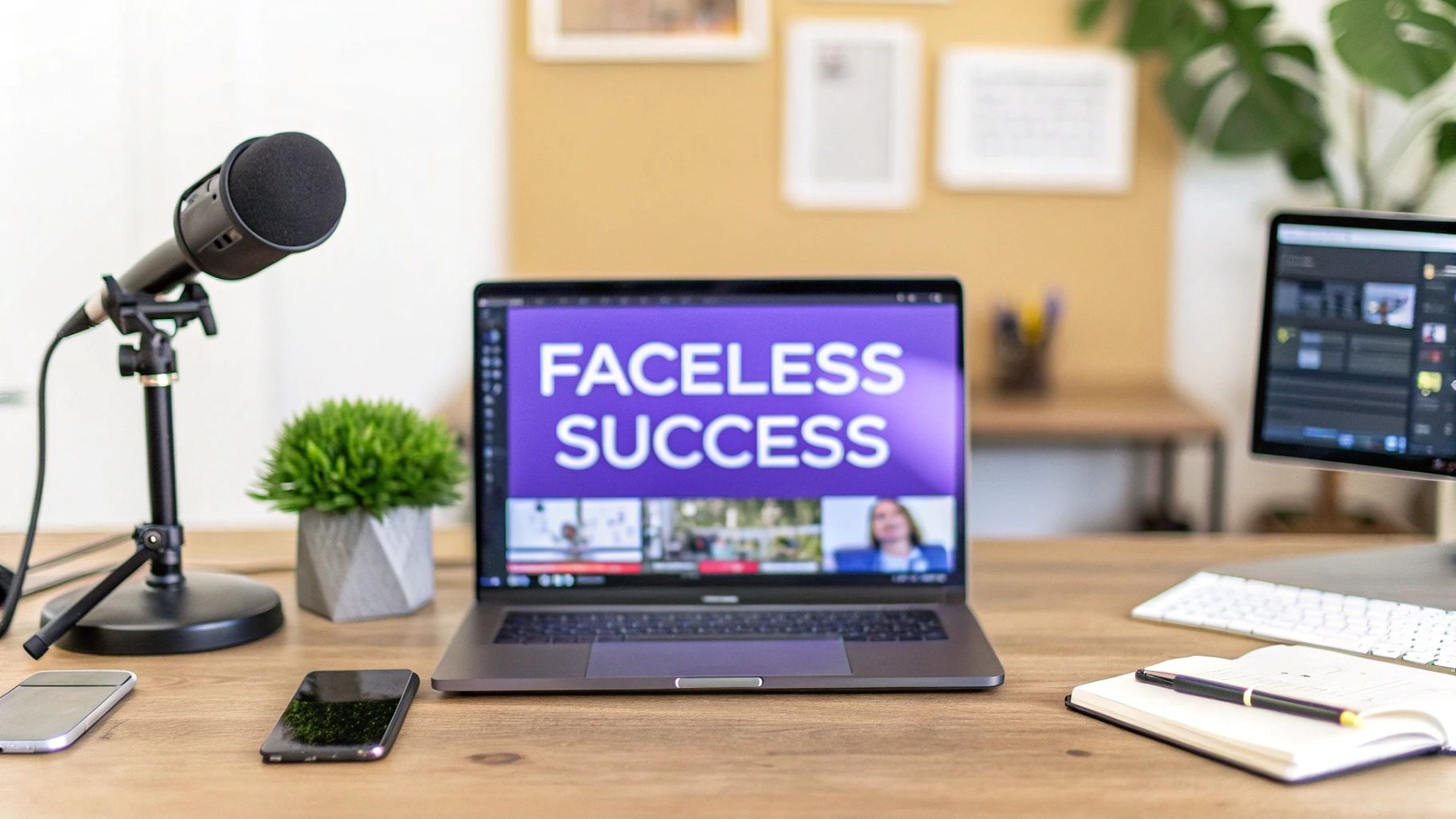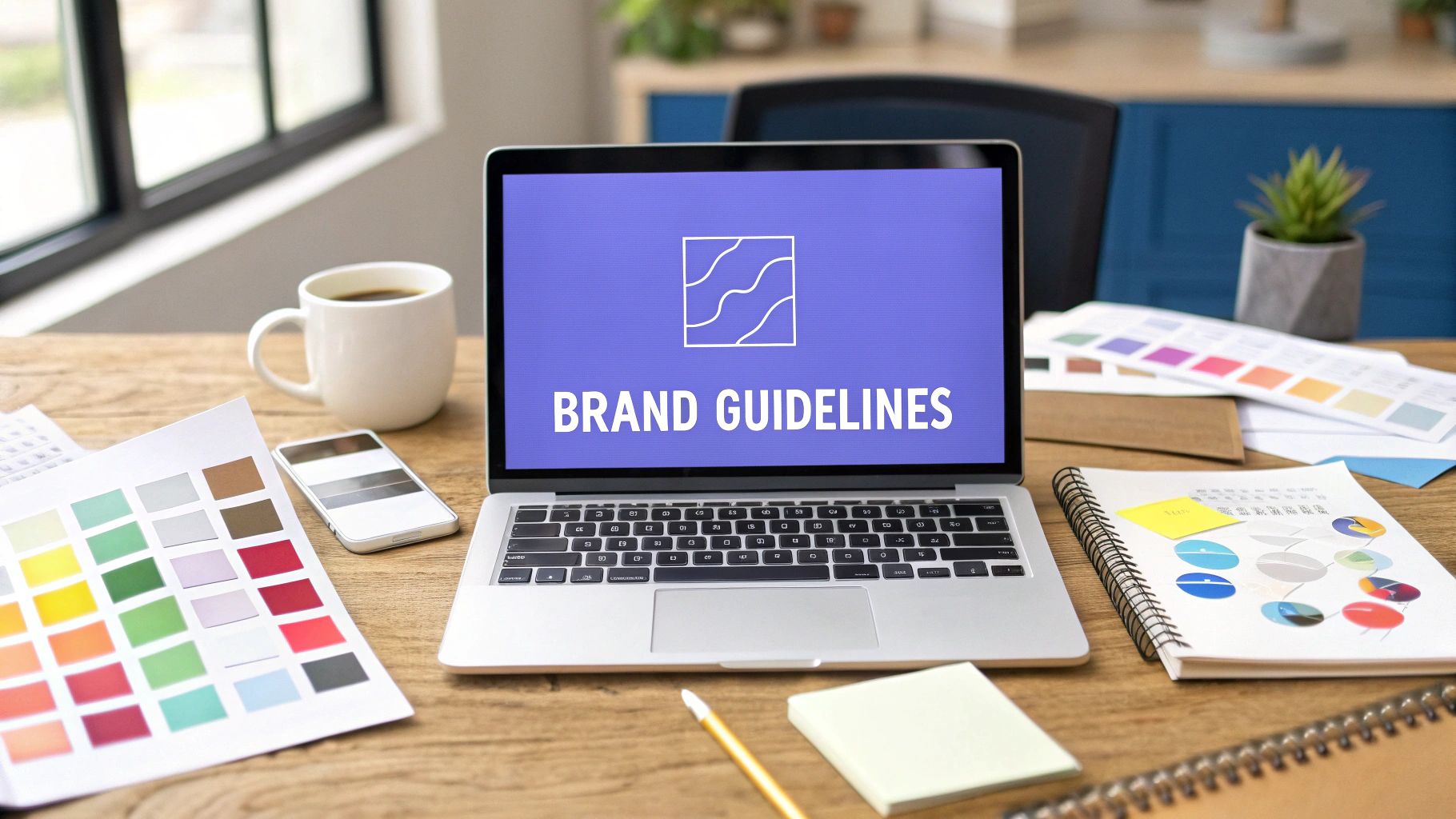So, you want to start a YouTube channel but the thought of being on camera is holding you back? You're not alone. The secret is to create what's called a "faceless" channel, where the star of the show is your content, not your face.
This whole strategy revolves around delivering high-value content using things like stock footage, screen recordings, animations, and AI voice generators instead of a camera pointed at you. It’s a popular route for creators who want to keep their privacy while still building a successful brand.
Why Faceless Channels Are Gaining Momentum

The idea of building a massive YouTube following without ever revealing your face might sound strange at first, but it's a trend that's absolutely exploding. For a lot of people, the biggest thing stopping them from hitting "record" isn't a lack of great ideas—it's the pressure of being on camera.
Faceless channels completely remove that barrier. Suddenly, the focus shifts from your personality to the pure value of your content.
But this isn't just about being camera-shy. It’s a smart, strategic move. You can produce incredibly high-quality, informative, or entertaining videos without dropping a fortune on cameras, lighting rigs, or a fancy studio. All you really need is your laptop.
The Power of Content-First Creation
When you go faceless, you’re not a personality; you’re a producer. Your brand isn't built on your charisma, but on the quality of your research, your storytelling, and how well you put your visuals together. This content-first approach has some serious perks:
- It’s Easier to Scale: Let's be honest, it's way faster to produce a video when you don't have to worry about filming yourself. This makes it much easier to stick to a consistent upload schedule, which the YouTube algorithm loves.
- You Can Obsess Over Quality: All your time and energy can go into what really matters: writing a killer script, sourcing the perfect visuals, and making sure the audio is crisp.
- No "Camera-Ready" Pressure: You can forget about the stress of looking perfect for the camera. This lets you create content whenever you feel inspired, no matter where you are or what you look like.
A lot of this growth is fueled by creators who either want to stay private or just don't feel like they have that "on-camera" energy. By leaning on great voiceovers, slick animations, and high-quality stock footage—all made easier with new AI tools—they're able to compete with the biggest names on the platform. If you're curious, you can dig deeper into the highest-paying faceless niches and see just how profitable this can be.
A compelling presence doesn't require a face; it requires value. Your ability to teach, entertain, or inspire is what builds a loyal audience, not your on-screen appearance.
At the end of the day, the rise of faceless channels proves one simple thing: a great idea, presented well, will always find an audience.
Finding Your Profitable Faceless Niche

Before you touch any software or record a single line of audio, you have to make the single most important decision for your faceless channel: picking your niche. This isn't just about what you'll make videos about; it’s the bedrock of your entire channel. It defines your audience, your content style, and most importantly, your potential to actually make money.
Don’t just jump on the latest trend. A channel that lasts is built on a sweet spot where three things meet: your genuine interest, what people are actually searching for, and real monetization potential. If any one of those is missing, you’re building on shaky ground.
How to Think About Niche Profitability
Making money on YouTube isn't just a numbers game about views. It's about the quality of those views. This is where a little metric called CPM (Cost Per Mille) becomes your best friend. It’s the amount advertisers are willing to pay for every 1,000 views on your videos.
Niches like personal finance, real estate, software tutorials, and investing attract advertisers with deep pockets. They consistently pull in much higher CPMs than, say, a channel that just posts funny animal clips.
Think about it this way: a finance channel might make $15-$25 per 1,000 views from ads alone. A channel with ambient rain sounds? They might only see $1-$3 for the same number of views. The difference is huge.
And AdSense is just the beginning. A great niche opens up other ways to earn:
- Affiliate Marketing: Tech reviews and "best software for X" channels are goldmines for affiliate links.
- Digital Products: Can you solve a viewer's problem with an ebook, a course, or a set of templates? This is common in productivity and business niches.
- Sponsorships: Brands love targeted audiences. A channel about historical war strategies is a perfect fit for a company that makes historical video games or model kits.
Finding the Balance: Your Passion vs. Audience Demand
Profitability is crucial, but if you don't actually care about your topic, you will burn out. Trust me. Your lack of enthusiasm will bleed through into your scripts and editing, and viewers can sense it a mile away. You need to find a subject you can see yourself creating content about for a long, long time.
To see if people are actually interested, start digging. Use a free tool like Google Trends to see if a topic's popularity is on the rise. Then, go straight to YouTube and search for your ideas. Are the top videos pulling in tens or even hundreds of thousands of views? That’s a fantastic sign that a hungry audience is already there.
If you need a spark of inspiration, exploring some proven faceless YouTube channel ideas can help you see what’s possible and what might click with your own skills.
Faceless YouTube Niche Potential Comparison
To help you weigh your options, I've put together a quick comparison of a few popular faceless niches. This table breaks down how they stack up in terms of making money, keeping viewers engaged, and how hard it is to actually find or create the content.
| Niche Idea | Monetization Potential | Audience Engagement | Content Sourcing Difficulty |
|---|---|---|---|
| Personal Finance/Investing | Very High (High CPMs, affiliate) | High (Viewers seek solutions) | Medium (Requires expertise, data) |
| History Documentaries | High (Sponsorships, long watch time) | High (Storytelling-driven) | High (Requires deep research, visuals) |
| Meditation/Relaxing Music | Low-Medium (Low CPMs) | Low (Passive listening) | Low (Easy to create, stock footage) |
| Software Tutorials | Very High (Affiliate, high CPMs) | Medium (Problem-solving focus) | Medium (Requires screen recording) |
| Luxury Lifestyle/Travel | High (Sponsorships, affiliate) | High (Aspirational content) | High (Requires high-quality stock) |
As you can see, the "easiest" niches to create content for often have the lowest direct monetization potential. The real money is often in topics that require more expertise and effort.
Ultimately, your mission is to get specific. Don't just start a "history" channel. Niche down to "Animated Naval Battles of the 18th Century." Instead of a generic "finance" channel, try "Passive Income Strategies for Millennials." That level of focus is what attracts a loyal, dedicated audience—the kind that advertisers love and that will support you for years to come.
Your Essential Faceless Content Toolkit
You don't need a Hollywood-sized budget to pull off professional-looking faceless videos. The real secret is building a smart, efficient toolkit of software that gets you from script to final video without a ton of hassle. Think of it as your own little digital production studio.
Your whole workflow really just boils down to three main stages. This simple flow shows you how an idea gets turned into a finished video.

Following a process like this just keeps you organized. It ensures each step naturally flows into the next, which is the key to producing content consistently. So, let's break down the specific tools that bring each of these stages to life.
Tools for Scripting and Voiceovers
Your script is the absolute foundation of your video, and the voiceover is what breathes life into it. This is where you set the tone and deliver your message. You've got a few ways to tackle this, depending on what you're comfortable with and what your budget looks like.
- Scriptwriting: Honestly, for just writing, Google Docs is a fantastic free tool. It’s collaborative, lives in the cloud, and makes organizing your thoughts a breeze. If you're stuck for ideas or need a hand structuring things, AI writing assistants can give you a solid first draft to work from.
- AI Voice Generation: Text-to-speech (TTS) has come a ridiculously long way from those old robotic voices. Tools like ElevenLabs or Murf.AI now offer incredibly realistic and emotional voices in all sorts of languages. They're pretty much perfect for a faceless YouTube channel.
- Recording Your Own Voice: If you'd rather use your own voice, you don't need a bunch of expensive gear. A simple USB mic like the Blue Yeti and free software like Audacity are more than enough to record and edit clean, crisp audio.
This mix of tools gives you a ton of flexibility. A huge part of the appeal of faceless channels is their anonymous, content-first vibe, which kind of redefines the whole creator-viewer relationship. Creators who lean on tools like text-to-speech and AI visuals sidestep the need for personal recording, which doubles down on that anonymity and lets them cover a much wider range of topics.
Software for Visuals and Editing
This is where it all comes together. You take your script and voiceover and mash them up with visuals to create the final product. Your video editor is your command center, so picking one you actually enjoy using is a big deal.
Your goal isn’t to master the most complex software out there. It’s about finding the right tool that lets you edit efficiently without a massive learning curve. Consistency will always beat complexity.
Here are a few of my top choices for different skill levels:
- For Beginners (and Pros): Platforms like Canva have grown into surprisingly capable video editors. They have a simple drag-and-drop setup and a massive built-in library of stock footage, animations, and templates. It makes them perfect for getting up and running fast.
- Industry Standards: If you find you need more fine-tuned control, DaVinci Resolve has a free version that’s packed with professional-grade color correction and editing features. For those willing to spend a bit, the Adobe Creative Cloud suite (Premiere Pro and After Effects) is the industry benchmark for a reason.
Sourcing Your B-Roll and Music
You absolutely cannot skimp on high-quality visuals and audio if you want to keep viewers hooked. Your B-roll (that's all your supplemental footage) and music are what set the mood and help illustrate your points.
- Stock Footage: Websites like Pexels and Pixabay have huge libraries of free, high-quality stock videos and images. If you need more premium, curated options, a subscription to a service like Storyblocks or Artgrid is an investment you won't regret.
- Royalty-Free Music: The right soundtrack can make or break your video, seriously. Epidemic Sound and Artlist are the go-to platforms for most successful creators. They have enormous libraries of music and sound effects you can use without ever worrying about copyright strikes.
Putting together your toolkit is the first real, practical step in this journey. For a deeper look at how AI can seriously speed this whole process up, check out our guide on the best AI tools for content creators, which gets into everything from scripting to generating visuals.
A Practical Workflow for Producing Faceless Videos
https://www.youtube.com/embed/_mCHBazEm2Q
Alright, you’ve picked your niche and gathered your tools. Now for the fun part: actually making the videos. This is where you build a repeatable system that lets you churn out great content without burning yourself out. A solid workflow is what separates the pros from the people who quit after three videos.
Let's walk through a real-world example to make this tangible. Say our faceless channel is all about weird history, and we're tackling the topic: "The Great Emu War: An Unbelievable True Story." It's a fantastic choice because it's dramatic, a little bit funny, and gives us a ton of visual ideas to play with.
From Blank Page to Polished Script
Every single good video I've ever made started with a solid script. It’s the blueprint for everything—the pacing, the visuals, the story itself. The first step isn’t just writing, it’s thinking like a video editor before you even type a word.
I’ve found that a simple structure works wonders for keeping viewers hooked:
- The Hook (First 30 seconds): Hit them with the most bizarre or captivating fact right away. For our video, something like, "In 1932, the Australian military declared war on birds… and the birds won." That line alone is enough to make someone stop scrolling.
- The Setup (Up to 2 minutes): Now, give them just enough context. Explain the post-WWI farming crisis in Western Australia and why 20,000 emus suddenly became public enemy number one.
- The Conflict (The juicy middle): This is the core of the story. You'll detail the actual "war"—Major Meredith leading soldiers armed with machine guns, their comical failures, and how the emus were surprisingly good at guerilla warfare.
- The Resolution (The final minute): Wrap it up. Tell them how it ended—the military's embarrassing withdrawal and the hilarious newspaper headlines that followed. Your final thought could be a quick reflection on just how unpredictable nature can be.
The most important thing? Write like you talk. You’re telling a friend an amazing story, not reciting an encyclopedia entry.
Bringing the Script to Life with Audio
With the script ready, it's time for the voiceover. This is what will carry the emotional weight of your video and glue all the visual pieces together.
If you’re going the AI route with a tool like ElevenLabs, play around with the different voice options. You might want a deep, classic documentary narrator or someone with a bit more energy. I've found it helps to paste the script in one paragraph at a time to check the pacing. Sometimes adding a comma or a period can completely change the AI's delivery for the better.
Recording your own voice? Find the quietest room you can. Your closet is often a surprisingly good choice! Speak clearly, but don't try to be someone you're not. Let your personality come through. And don't stress about mistakes—you can chop out any stumbles or long pauses later with free software like Audacity.
Assembling the Visual Story
Now we get to put it all together. The goal here is to make sure your visuals are always supporting what the narrator is saying, creating a seamless and engaging experience. Honestly, this is where you'll spend most of your time.
First thing's first: drop your finished voiceover onto your timeline in your video editor. That audio track is now your map for the entire edit.
- Gather Your Assets: Before you do anything else, collect all your visuals. For the Emu War video, that means hitting up stock footage sites like Pexels for clips of Australian landscapes, old military footage, and lots of running emus. You’ll also want to find some historical photos to ground the story in reality.
- Pacing is Everything: Nobody wants to stare at a static image for 20 seconds. A great rule of thumb is to change the shot or add some subtle movement (like a slow zoom or pan) every 4-7 seconds. It keeps the viewer's eyes moving and their brain engaged.
- Add Music and Sound Design: Music is a shortcut to emotion. Find a royalty-free track on a site like Epidemic Sound that matches the vibe—maybe something a little dramatic but also quirky. Then, sprinkle in sound effects. The rattle of a machine gun, the sound of birds... these little details make a world of difference.
A well-produced faceless video isn't just a slideshow with a voiceover. It's a carefully choreographed dance between words, images, and sound that tells a compelling story.
If you want to dig deeper into the technical side, check out this expert's actionable guide on making AI-generated videos. For an even faster approach, our own guide on how to make AI videos breaks down how all-in-one platforms can really speed up this process.
By sticking to a structured workflow like this, you create a system that makes producing content for your faceless channel not just manageable, but scalable.
Growing Your Channel Without Showing Your Face

Look, making amazing videos is just one piece of the puzzle. The real challenge is getting eyeballs on them. When you're running a faceless channel, you can't rely on your personality on camera to draw people in. Instead, your growth depends almost entirely on mastering YouTube SEO and creating a genuine connection through the sheer value of your content.
Your titles and descriptions are your front-line soldiers in the war for attention. Don't just slap a title on and call it a day. Think like your viewer: what words would they actually type into the search bar? Get familiar with keyword research tools to find those golden phrases and craft your titles around them.
A great title hooks them, but a solid description is what convinces the YouTube algorithm your video is the real deal, helping it get in front of the right people.
Your Thumbnail Is Everything
On YouTube, the thumbnail is your movie poster, your book cover, your digital billboard. It’s often the only thing that determines whether someone clicks or keeps scrolling. Since you aren't using your face, your design game needs to be incredibly sharp.
- Go Bold with Color: Think high contrast. You need colors that stand out against YouTube's white, grey, and dark modes. Bright yellows, deep reds, and electric blues work wonders.
- Keep Text Big and Brief: Limit yourself to just a few powerful words. If someone can't read it instantly on their phone, you've already lost them.
- Spark Curiosity with Imagery: Use a crisp, high-quality graphic or image that makes people ask, "What's that about?" If your video covers a historical mystery, find a compelling, evocative photo from that era.
Your thumbnail isn't just a pretty picture; it's a promise. It tells a potential viewer exactly what they’re going to get, and it's your single best shot at cutting through the noise.
Build Your Tribe Through Interaction
It’s a total myth that you can’t build a loyal community without showing your face. You absolutely can, you just have to shift your focus. Your comment section? That's your new town square.
Get in there and talk to people. Make it a daily habit to reply to as many comments as you can. Ask follow-up questions. Pin the most insightful or funny responses to the top. This is how you prove there's a real, passionate person behind the channel, and that's what builds loyalty.
Don't forget to spread your content around. A fantastic tactic is to slice up your long-form videos into bite-sized, attention-grabbing clips. If you're not already doing this, learning the ropes of uploading YouTube Shorts can give you a massive boost in reach.
By zeroing in on smart SEO and genuine engagement, you can build a thriving community that's there for your content, not your face.
Answering Your Burning Questions About Faceless Channels
Even with the best game plan, it's totally normal to have a few questions rattling around in your head. When I first started, I kept wondering if this whole faceless thing was actually a viable path or if I was missing some secret catch. Let's tackle some of the biggest concerns head-on.
The number one question I hear is always about the money. "Can you really get monetized without showing your face?"
Absolutely, 100% yes. YouTube's rules for monetization are about the content, not the creator's face. As long as you’re creating original videos that follow their community guidelines (so, no just ripping and re-uploading other people's stuff), you are just as eligible for the YouTube Partner Program as anyone else.
But Are They Actually Profitable?
Okay, so they can be monetized. But can they make real money? The answer to that might surprise you. Some of the most successful channels out there are completely faceless, and they pull in serious revenue.
Smart creators don't just rely on ad money. They build multiple income streams.
One creator anonymously shared their income report, and it was mind-blowing: $80,000 in a single month. That wasn't just from ads; it was a powerful mix of course sales, affiliate links, and brand deals. If you want to see what's possible, you can watch the full breakdown on YouTube.
The takeaway here is that your channel's value comes from the quality of your content and the community you build around it. A high-value faceless channel can easily out-earn a personality-based one.
How Do I Handle Copyright with Stock Footage?
This is another huge one. The idea of navigating copyright law, especially when you're using stock clips or AI tools, can feel intimidating. But it doesn't have to be.
Here’s how you stay in the clear:
- Stick to legit sources. This is non-negotiable. Use reputable, royalty-free libraries for your visuals and music. Services like Pexels, Storyblocks, or Epidemic Sound exist for this very reason. Their licenses are built to protect you.
- Know YouTube's AI rules. YouTube now asks creators to disclose when realistic content is "altered or synthetic." For most faceless videos using animation or stylized AI, it's less of a concern, but transparency is always a good policy.
- Create something new. This is the golden rule. Don't just string together stock clips. Your job is to transform those assets. Combine them with your original script, your unique voiceover, and your own editing flair to make something that is truly yours.
Once you get your head around these common issues, you can start building with a lot more confidence. You'll know you're creating a channel that's not just engaging, but also built to last.
Ready to bring your video ideas to life without ever stepping in front of a camera? With Sprello, you can generate scripts, create stunning B-roll, and produce high-quality social content in minutes using advanced AI. Streamline your entire workflow and start building your faceless empire today. Discover how Sprello can transform your content creation.



